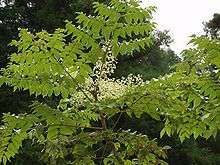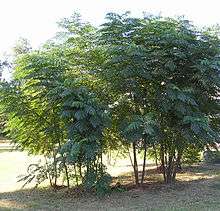Aralia
| Aralia | |
|---|---|
 | |
| Aralia elata | |
| Scientific classification | |
| Kingdom: | Plantae |
| (unranked): | Angiosperms |
| (unranked): | Eudicots |
| (unranked): | Asterids |
| Order: | Apiales |
| Family: | Araliaceae |
| Subfamily: | Aralioideae |
| Genus: | Aralia L. |
| Synonyms | |
Aralia /əˈreɪliə/,[1] or spikenard, is a genus of the family Araliaceae, consisting of 68 accepted species of deciduous or evergreen trees, shrubs, and rhizomatous herbaceous perennials. The genus is native to Asia and the Americas, with most species occurring in mountain woodlands. Aralia plants vary in size, with some herbaceous species only reaching 50 centimetres (20 in) tall, while some are trees growing to 20 metres (66 ft) tall.
Aralia plants have large bipinnate (doubly compound) leaves clustered at the ends of their stems or branches; in some species the leaves are covered with bristles. The stems of some woody species are quite prickly, as in Aralia spinosa. The flowers are whitish or greenish occurring in terminal panicles, and the spherical dark purple berry-like fruits are popular with birds.
Aralia species are used as food plants by the larvae of some Lepidoptera species, including the common emerald (Hemithea aestivaria). There are many colours of aralia flowers. The main flower is whitish aralia.
Some species, notably Aralia cordata, are edible and are cultivated for human consumption.
Taxonomy
The taxonomic circumscription of the genus Aralia has varied greatly. Species formerly included in wider views of the genus are now included in such separate genera as Fatsia, Macropanax, Oreopanax, Panax, Polyscias, Pseudopanax, Schefflera, and Tetrapanax.
The genus Dimorphanthus, formerly considered distinct by some, is now included within Aralia as a section within that genus.
Fossil record
Aralia macrofossils have been recovered from the late Zanclean stage of Pliocene sites in Pocapaglia, Italy.[2]
Diversity
- Aralia apioides
- Aralia armata
- Aralia atropurpurea
- Aralia bicrenata
- Aralia bipinnata
- Aralia cachemirica
- Aralia caesia
- Aralia californica - California aralia
- Aralia castanopsiscola
- Aralia chapaensis
- Aralia chinensis - Chinese angelica tree
- Aralia continentalis
- Aralia cordata - Japanese spikenard
- Aralia dasyphylla
- Aralia dasyphylloides
- Aralia debilis
- Aralia decaisneana
- Aralia delavayi
- Aralia echinocaulis
- Aralia elata - Japanese angelica-tree
- Aralia fargesii
- Aralia ferox
- Aralia finlaysoniana
- Aralia foliolosa
- Aralia fragrans
- Aralia frodiniana
- Aralia gigantea
- Aralia gintungensis
- Aralia glabra
- Aralia glabrifoliolata
- Aralia henryi
- Aralia hispida - bristly sarsaparilla, bristly spikenard
- Aralia houheensis
- Aralia humilis
- Aralia kansuensis
- Aralia kingdon-wardii
- Aralia laevis
- Aralia leschenaultii
- Aralia malabarica
- Aralia melanocarpa
- Aralia merrillii
- Aralia mexicana
- Aralia montana
- Aralia nguyen-taoi
- Aralia nudicaulis - wild sarsaparilla, small spikenard
- Aralia parasitica
- Aralia plumosa
- Aralia racemosa - American spikenard
- Aralia regeliana
- Aralia rex
- Aralia ryukyuensis
- Aralia scopulorum
- Aralia searelliana
- Aralia soratensis
- Aralia spinifolia
- Aralia spinosa - devil's walkingstick, Hercules' club
- Aralia stellata
- Aralia stipulata
- Aralia subcordata
- Aralia thomsonii
- Aralia tibetana
- Aralia tomentella
- Aralia undulata
- Aralia urticifolia
- Aralia verticillata
- Aralia vietnamensis
- Aralia warmingiana
- Aralia wilsonii
- Aralia yunnanensis
Notes
References
- Frodin, D. G. and R. Govaerts. 2003. World Checklist and Bibliography of Araliaceae. Kew, UK: The Royal Botanic Gardens, Kew.
- Wen, J. 2004. Systematics and biogeography of Aralia L. sect. Dimorphanthus (Miq.) Miq. (Araliaceae). Cathaya 15-16: 1-187.
External links
| Wikimedia Commons has media related to Aralia. |
